How Much Does It Cost to Build a Concert Hall?
Building a concert hall typically costs between $11,845,000 and $24,900,000, translating to $395 to $830 per square foot for a 30,000 sq ft facility. This total cost includes construction, materials, specialized lighting and sound systems, seating, stage equipment, and interior finishes. Lower-end costs cover basic designs and standard materials, while higher-end costs involve premium materials, advanced technology, custom acoustics, and additional features like VIP areas and artist facilities. Factors influencing the cost per square foot include design complexity, material quality, local labor rates, and specific performance requirements.
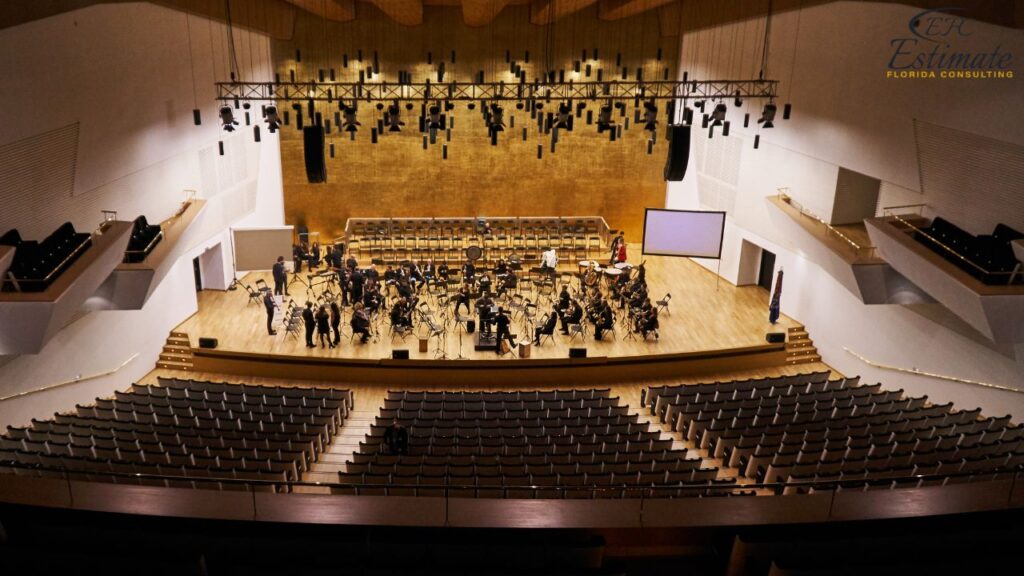
Proper planning and budgeting for unforeseen expenses are essential to keep the project within the estimated cost range.
Detailed Cost Breakdown for Building a Concert Hall
Site Preparation
Site preparation includes land acquisition, clearing, grading, and any necessary site improvements such as utilities and access roads. These costs can vary based on the location and condition of the land. Proper site preparation is essential to ensure a stable foundation and smooth construction process.
Component | Estimated Cost (in dollars) |
Land Acquisition | $250,000 – $1,200,000 |
Site Clearing and Grading | $60,000 – $200,000 |
Utilities and Infrastructure | $150,000 – $400,000 |
Site preparation is a critical step in the construction process, as it involves ensuring that the land is suitable for building. This phase can also include environmental assessments and the removal of any existing structures or debris. Proper site preparation can prevent future issues such as foundation settling or water drainage problems. Ensuring the land is appropriately graded and prepared can also enhance the durability and safety of the concert hall’s foundation.
Construction
Construction costs cover the main building structure, including the foundation, walls, roof, and interior finishes. This category also includes labor costs, permits, and inspections. The complexity and design of the concert hall will influence these costs.
Component | Estimated Cost per Sq Ft (in dollars) | Total Cost for 25,000 Sq Ft Concert Hall (in dollars) |
Foundation and Structure | $120 – $250 | $3,000,000 – $6,250,000 |
Roofing and Exterior | $60 – $120 | $1,500,000 – $3,000,000 |
Interior Finishes | $90 – $180 | $2,250,000 – $4,500,000 |
Labor | $60 – $120 | $1,500,000 – $3,000,000 |
Permits and Inspections | $60,000 – $200,000 | $60,000 – $200,000 |
Construction involves multiple phases, from laying the foundation to installing the roof and finishing the interiors. Each phase requires careful planning and execution to ensure that the building meets all safety and quality standards. High-quality construction can enhance the longevity and durability of the concert hall. Using high-quality materials and employing skilled labor can also ensure that the concert hall meets aesthetic and functional requirements, providing a safe and enjoyable environment for both performers and audiences.
Technology and Equipment
Technology and equipment costs include lighting, sound, staging, and other technical systems necessary for performances and presentations. Investing in high-quality equipment ensures the concert hall can host a wide range of events.
Component | Estimated Cost (in dollars) |
Lighting Systems | $400,000 – $800,000 |
Sound Systems | $300,000 – $600,000 |
Staging Equipment | $200,000 – $400,000 |
Projection and AV Equipment | $150,000 – $300,000 |
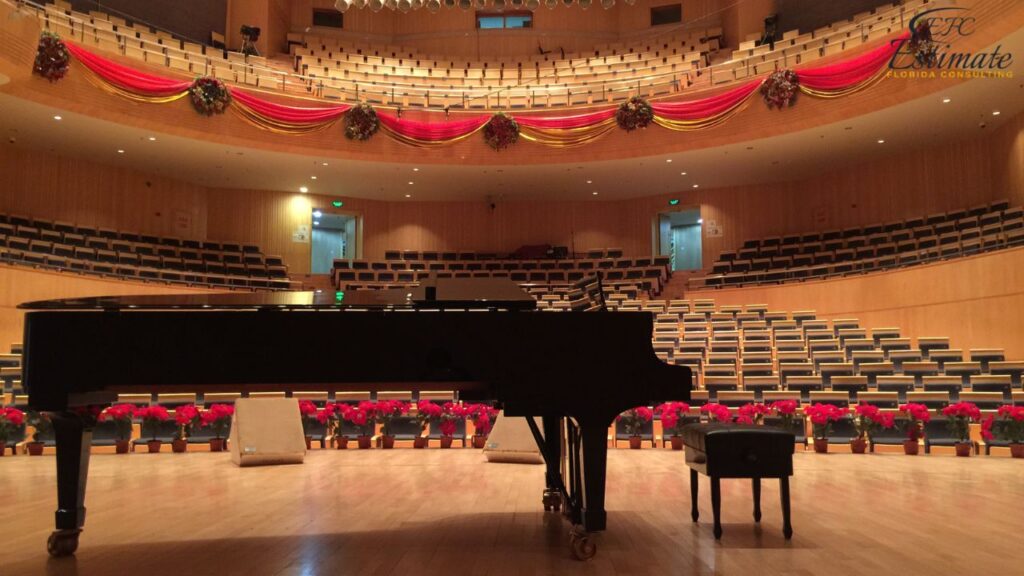
Advanced technology and equipment are essential for providing high-quality performances and presentations. This includes not only the primary systems like lighting and sound but also supplementary equipment such as microphones, speakers, and control boards. High-quality equipment can significantly enhance the performance experience for both the audience and the performers. Investing in versatile and upgradable systems can also future-proof the concert hall, ensuring it can adapt to new technological advancements and continue to provide high-quality productions.
Additional Facilities and Amenities
Additional facilities such as dressing rooms, administrative offices, backstage areas, and concessions areas add to the overall cost. These spaces enhance the functionality and user experience of the concert hall.
Component | Estimated Cost (in dollars) |
Dressing Rooms | $100,000 – $200,000 |
Administrative Offices | $200,000 – $400,000 |
Backstage Areas | $150,000 – $300,000 |
Concessions and Lobby Areas | $300,000 – $600,000 |
These additional facilities are crucial for the concert hall’s operations. Dressing rooms provide performers with necessary spaces to prepare, while administrative offices are needed for the management team. Backstage areas are essential for the logistical aspects of events, and concessions and lobby areas enhance the audience’s experience by providing amenities and spaces to socialize before and after events. Providing comprehensive facilities can support a wide range of productions and events, increasing the concert hall’s versatility and appeal.
Contingency and Miscellaneous Costs
A contingency fund covers unexpected expenses and changes during the construction process. Miscellaneous costs may include insurance, legal fees, and marketing for the grand opening.
Component | Estimated Cost (in dollars) |
Contingency Fund | $600,000 – $1,200,000 |
Insurance and Legal Fees | $150,000 – $300,000 |
Marketing and Promotion | $100,000 – $200,000 |
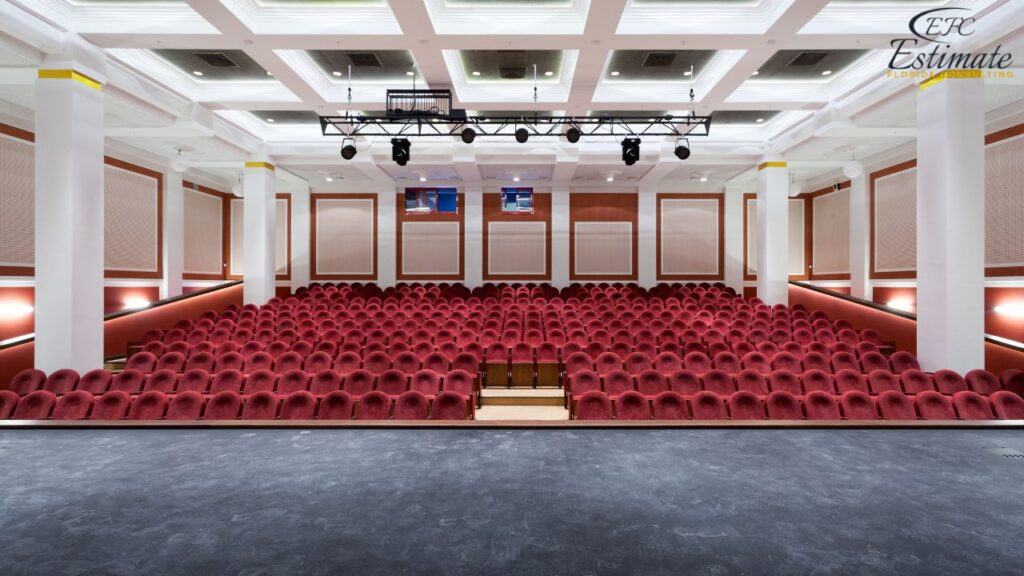
A contingency fund is essential to cover any unexpected costs that may arise during construction. This could include unforeseen site issues, design changes, or material price increases. Insurance and legal fees ensure that the project complies with all regulations and is protected against potential liabilities. Marketing and promotion are crucial for generating interest and attendance for the concert hall’s opening and ongoing operations. A well-executed marketing campaign can help establish the concert hall as a cultural landmark and attract a loyal audience base.
Furniture and Fixtures
Furniture and fixtures are essential for creating a comfortable and functional environment. This includes seating, office furniture, and lobby decor.
Component | Estimated Cost (in dollars) |
Seating | $300,000 – $600,000 |
Office Furniture | $75,000 – $150,000 |
Lobby Decor | $50,000 – $100,000 |
High-quality furniture and fixtures can enhance the aesthetic appeal and functionality of the concert hall. Comfortable seating can improve the audience experience, while well-designed office spaces and lobby areas can streamline operations and create a welcoming atmosphere.
Maintenance and Operations
Ongoing maintenance and operational costs are important to consider. This includes utilities, staffing, and routine maintenance.
Component | Estimated Annual Cost (in dollars) |
Utilities | $150,000 – $300,000 |
Staffing | $300,000 – $600,000 |
Maintenance | $75,000 – $150,000 |
Regular maintenance is crucial to keeping the concert hall in good working order. This includes everything from cleaning and repairs to system upgrades and inspections. Proper maintenance can extend the life of the building and its systems, ensuring the concert hall remains a valuable community asset.
Download Template For Concert Hall Project Breakdown
- Materials list updated to the zip code
- Fast delivery
- Data base of general contractors and sub-contractors
- Local estimators

Fundraising and Sponsorship
To cover the high costs of building and maintaining a concert hall, fundraising and sponsorship efforts are often necessary. This can include grants, donations, and corporate sponsorships.
Component | Estimated Fundraising Goal (in dollars) |
Grants and Donations | $1,200,000 – $6,000,000 |
Corporate Sponsorship | $600,000 – $2,400,000 |
Effective fundraising and sponsorship efforts can significantly offset construction and operational costs. Engaging with the community and potential sponsors can build support for the concert hall and secure necessary funds. Successful fundraising campaigns can also enhance community involvement and investment in the concert hall’s future.
Factors Affecting Construction Costs
Size and Capacity
The size and seating capacity of the concert hall significantly impact the overall construction cost. Larger concert halls with higher seating capacities require more extensive construction, more materials, and larger support facilities such as lobbies, restrooms, and concession areas. The design must also consider acoustics, sightlines, and audience comfort to ensure a high-quality experience. Additionally, larger concert halls may need more complex HVAC systems, advanced soundproofing, and enhanced safety features. The architectural design must balance aesthetic appeal with functional requirements to create an inviting and efficient space. The larger the concert hall, the more sophisticated and costly the design solutions required to maintain excellent acoustics and visibility for every seat.
Location
The location of the concert hall can affect construction costs due to variations in land prices, labor rates, and local building codes and regulations. Urban areas may have higher land and labor costs compared to rural locations. Additionally, location-specific factors such as soil conditions and climate can influence construction methods and materials. The proximity to suppliers and availability of local resources can also impact logistical costs. Building in a high-traffic area may increase initial costs but can provide greater long-term benefits in terms of visibility and accessibility. Location also affects future operational costs and potential revenue, making it a critical consideration in the planning phase. For instance, a centrally located concert hall might attract larger audiences and more diverse events, contributing to its financial viability.
Design and Materials
The design and quality of materials used in construction play a crucial role in determining the overall cost. High-end finishes, custom architectural features, and state-of-the-art technology for lighting, sound, and staging can increase expenses. Sustainable and energy-efficient building practices may also add to the initial cost but can result in long-term savings and environmental benefits. Investing in durable, high-quality materials can reduce maintenance and repair costs over time, ensuring the concert hall remains in good condition for many years. Moreover, the aesthetic appeal and functionality of the design can influence the concert hall’s ability to attract audiences and events, impacting its revenue potential. High-quality materials also contribute to the longevity and resilience of the building, ensuring it can withstand heavy use and remain a valuable community asset for decades.
Facilities and Amenities
The inclusion of additional facilities and amenities such as dressing rooms, administrative offices, backstage areas, and concession stands can impact the cost. The quality and quantity of these features should align with the concert hall’s intended use and target audience. Investing in modern amenities enhances the functionality and attractiveness of the concert hall. Comprehensive facilities can support a wider range of productions and events, increasing the concert hall’s versatility and appeal. Providing comfortable and well-equipped spaces for performers and staff can enhance their experience and contribute to the overall success of events.
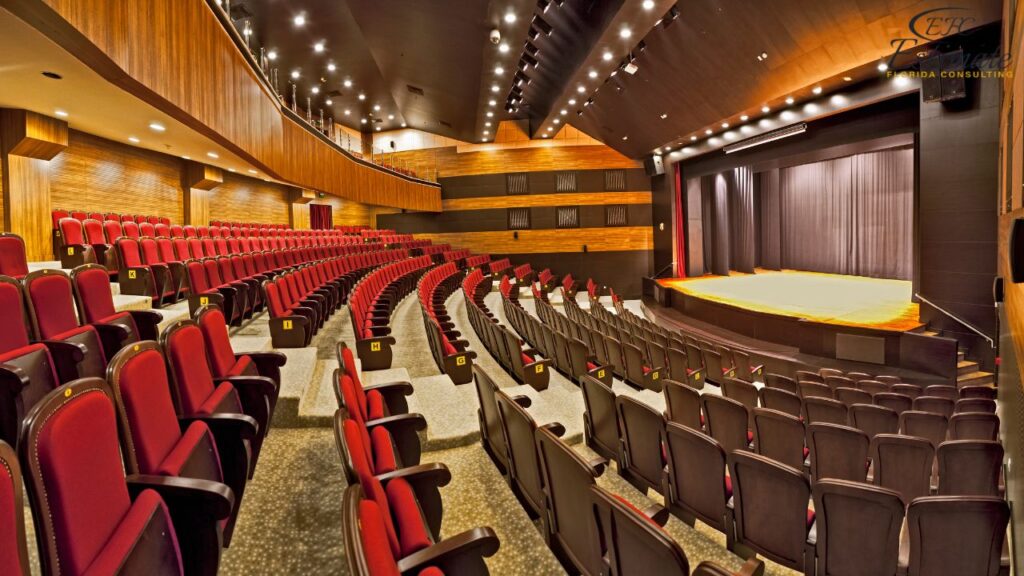
The availability of such amenities can also make the concert hall a preferred venue for touring companies and special events.
Technology and Equipment
Modern concert halls require advanced lighting, sound, and staging equipment to provide high-quality performances. The cost of these systems can vary widely based on the complexity and specifications. Investing in cutting-edge technology ensures that the concert hall can host a wide range of events and meet the technical requirements of different productions. High-quality equipment can enhance the audience’s experience, making performances more engaging and memorable. Additionally, investing in versatile and upgradable systems can future-proof the concert hall, allowing it to adapt to emerging trends and technologies in the performing arts industry. Advanced technology can also improve the efficiency and effectiveness of concert hall operations, from ticketing to backstage management.
Benefits of Building a Concert Hall
Cultural Enrichment
A concert hall provides a dedicated space for musical performances, enhancing the cultural landscape of the community. It offers a venue for local, national, and international artists to showcase their talents, fostering an appreciation for music and the arts. The concert hall can host a variety of events, including classical music concerts, jazz performances, rock shows, and more, catering to diverse musical tastes. This enrichment extends to community engagement, as the hall can host educational programs, workshops, and other events that promote cultural awareness and appreciation.
Economic Impact
The construction and operation of a concert hall can stimulate the local economy. It creates jobs during the construction phase and ongoing employment opportunities for staff, performers, and support services. Additionally, concert halls attract visitors, which benefits local businesses such as restaurants, hotels, and retail shops. Hosting large events can draw audiences from surrounding areas, boosting tourism and related economic activities. The increased foot traffic can lead to higher revenues for local businesses and can help revitalize nearby commercial areas. The economic ripple effect can extend to increased demand for local artisans, catering services, and transportation providers.
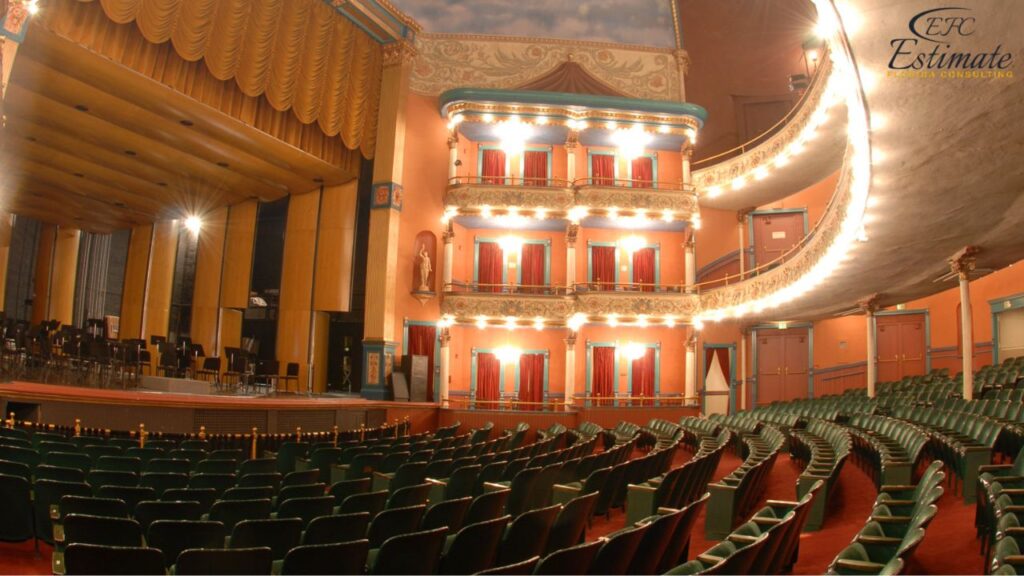
Community Engagement
A concert hall serves as a community hub, bringing people together for shared experiences. It can host community events, educational programs, and cultural performances, promoting social interaction and engagement. By providing a space for local artists and organizations to showcase their work, the concert hall fosters a sense of pride and ownership within the community. This engagement can lead to the formation of partnerships and collaborations between different community groups, enhancing social cohesion. The concert hall can also be a venue for civic meetings, public forums, and other community-centric activities, strengthening its role as a vital community asset.
Educational Opportunities
Concert halls provide valuable educational opportunities by offering spaces for music education, workshops, masterclasses, and other educational events. Partnerships with schools and educational institutions can provide students with unique learning experiences. These educational initiatives can inspire the next generation of musicians, cultivating a lifelong appreciation for the arts. Students can benefit from hands-on learning opportunities, exposure to professional performances, and the chance to engage with experts in various musical fields. The concert hall can also serve as a venue for student performances, providing a platform for showcasing their talents and achievements.
Get 5 New Leads Next 7 Days With Our System
- Multi-Family House
- Single-Faimly House
- Modern House
- Duplex
- Ranch House
- Bungalow
Conclusion
Building a concert hall is a substantial investment that can provide numerous benefits, including cultural enrichment, economic impact, community engagement, and educational opportunities. By understanding the various costs involved, including site preparation, construction, technology and equipment, additional facilities, and contingency funds, you can effectively plan and budget for your project. Proper planning and budgeting are crucial to ensuring a successful construction project that meets the needs of the community and provides a versatile, high-quality venue for a wide range of events. Investing in a concert hall not only enhances the cultural and educational fabric of the community but also supports local economic development, providing a lasting legacy for future generations.
FAQs
The cost of building a concert hall typically ranges from $11,845,000 to $24,900,000, which translates to approximately $395 to $830 per square foot for a 30,000 sq ft facility.
Factors affecting the cost per square foot include the complexity of the design, quality of materials, local labor rates, and specific performance requirements such as acoustics and lighting.
The total cost includes construction, materials, specialized lighting and sound systems, seating, stage equipment, and interior finishes. Additional facilities like dressing rooms, administrative offices, backstage areas, and concessions areas are also part of the cost.
A contingency fund, estimated at $600,000 to $1,200,000, covers unexpected expenses such as unforeseen site issues, design changes, or material price increases. It’s crucial for maintaining the project’s budget.
Estimated annual costs for maintaining and operating the concert hall include:
- Utilities: $150,000 – $300,000
- Staffing: $300,000 – $600,000
- Maintenance: $75,000 – $150,000
Regular maintenance keeps the concert hall in good working order, ensuring it remains a valuable community asset.
Google Reviews



Process To Get Concert Hall Cost Estimate Report
Here I am going to share some steps to get concert hall cost estimate report.
-
You need to send your plan to us.
You can send us your plan on info@estimatorflorida.com
-
You receive a quote for your project.
Before starting your project, we send you a quote for your service. That quote will have detailed information about your project. Here you will get information about the size, difficulty, complexity and bid date when determining pricing.
-
Get Estimate Report
Our team will takeoff and estimate your project. When we deliver you’ll receive a PDF and an Excel file of your estimate. We can also offer construction lead generation services for the jobs you’d like to pursue further.

